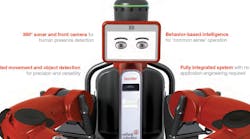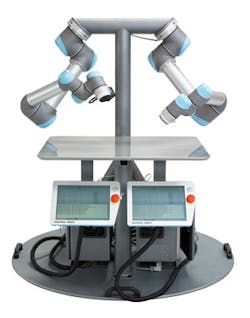Five months ago, a pair of boxes bearing the return address of Universal Robots in Odense, Denmark, showed up on the receiving dock of custom faucet maker RSS Manufacturing & Phylrich.
In those boxes were the pieces and parts of a sleek, gray robotic arm, articulated with six rotating joints and capped with an array of grippers and attachments capable of mimicking the motion and skill of just about any of the 72 trained workers in the Costa Mesa, Calif., factory. Also included was a short video that explained how the UR5 robot would begin doing just that within the hour.
See Also: Manufacturing Industry Technology News & Trends
Somewhere in the mix of hardware and cabling in those boxes, between controllers and packing peanuts, was tucked a little glimpse of the future -- the future of both the company and of American manufacturing.
The crew at RSS regarded that future with a mix of emotions. There was trepidation from hourly workers like Jessie Toller, whose job feeding CNC machines would be taken over by this robot in the next few days. And on the other end, automation specialists like Shane Strange stood by happy and eager to take on all of the new work it would bring his way.
"This robot is our key to competing on a global scale," he says. "To go against Asia, we need larger capacity, we need to be more profitable and put more into new products and growth. And this is how we will do it."
Rise of the Robots
Just a couple of years ago, Escalette wouldn't have had the opportunity to make this kind of bet on his company's future.
The industrial robots that have meant so much to the automotive manufacturing industry -- those great yellow Fanucs and their like that toss engine blocks like toys between assembly lines or spot-weld components with super-human speed and precision -- have always been out of reach for small and midsize manufacturers. From the unit costs to the programming requirements to the floor space they require, big-time robots have only ever found a place in big-time factories.
But those are the robots of a different age.
In small factories and medium-sized enterprises across the country, a new generation of robots is zipping around assembly lines delivering parts, running operations, communicating and collaborating with workers, and giving a helping hand at every phase of the manufacturing process, from assembly and warehousing to packaging and shipping, and for every level of business, from multinational corporations to one-man shops.
Enabled by new advances in sensor technologies and the proliferation of object detection, 3-D imaging and human interface software, robots have officially emerged from behind the light curtains and into the spotlight of American small business.
Shining brightest in that spotlight is a little guy named Baxter.
Meet Baxter
Since popping up in the market last September, Rethink Robotics' Baxter unit has become a rock star of automation. Baxter's face, with its calm, digital eyes, has become a familiar sight at trade shows and on assembly lines, as has its slow, careful, very un-robot-like way of maneuvering parts on the line.
"Baxter is a totally different category of robot," explains Rethink CEO Scott Eckert. "Our approach was to focus on human levels of speed and strength and precision at a dramatically lower price point. And most importantly, we wanted to make it easy enough to use that anybody in the factory could train it."
This really is a fundamental shift in robotics. It marks a movement away from the superheroics of the ultra-fast, ultra-precise, ultra-strong industrial robots and toward a breed of machines that really do resemble their human counterparts. To an unsettling degree.
That may be what has made Baxter such a hit. It comes equipped with two arms set on human-like shoulders with padded, almost flesh-like angles. Between them, the interface screen displays a set of eyes whenever the machine is in motion, which track what it is working on and where it is going next, conveying its intentions and status to its coworkers subconsciously through a body language one would never expect from a machine.
Unlike any industrial robots that came before them, Baxter and the UR5 were created to run cage-free as true "collaborative robots."
"The direct interaction with the robot has always been a key part of the overall objective of the company," Eckert explains. "To us, that meant making the robot have enough of a character through the eyes that you feel comfortable with it. It's not intimidating. "
And that's certainly true. The internet is littered with pictures of workers posed alongside their Baxters, thumbs up and smiling proud -- something Eckert notes would never occur to them to do with a giant industrial welder
To ensure, or at least promote, safety in those interactions, both Rethink and Universal Robots have taken a human approach to their basic robot design. They run slow, carrying small weights small distances at a speed unlikely to do much damage and then come equipped with sensitive pressure mechanisms that stop the works if any unexpected contact occurs.
Baxter is also equipped with advanced sonar and sensors that track its environment and any movement near it so it can detect and react to its coworkers just as they do with each other.
"These collaborative robots are aware of their environments," Eckert explains. "That's an important difference from prior generations of robots. Once you make them aware, you can start building in safety mechanisms because they know people are there or objects are there. That's a fundamental change."
"Know" is the key point there.
In addition to everything else, these new robots are smart. They come equipped with intelligence enough to understand their environment, adapt to change, make decisions, even recognize the parts they're working on from a pile.
That feature alone changes the whole programming dynamic. The giant automotive robots require weeks of expensive, precise programming to even get started, which makes them perfect for long-run, heavy-duty manufacturing. Baxter, on the other hand, needs just an hour or two of training for a new task. Just the basics, though. It can work out the details on its own. And that is the right fit for small manufacturers making their profits on short-run jobs and quick changeovers.
In essence, what is happening here is the new generation of robots is starting to seem less like industrial tools and more like human workers -- a scenario that never seems to end well in the movies. And when you slap a price tag on these robots -- somewhere between $25,000 and $35,000 for a startup kit -- the whole scheme comes into focus.
For about the same cost as a low-skilled laborer's salary, you can now buy a robot capable of doing low-skilled labor. The human and robot require the same amount of training, and they perform the same basic tasks in the same basic manner. But the latter will do so for 24 hours a day without complaint, without food, without taking a nap or asking for a raise. It is the perfect, tireless employee with whom no human laborer could ever compete.
And that seems to scare some people.
Robot Takeover
Jeff Burnstein, president of the Robotic Industries Association (RIA), rattles at the very mention of a robot takeover.
"Whenever you talk about automation, people think you're talking about taking jobs from people," he says. "But that's just not true."
Robots, he says, whether these smart, collaborative sort or the old powerhouses, are there to help achieve greater quality and productivity on jobs that humans don't want to do or that are too dangerous to do.
"We're talking about pick and place, about dull and dangerous jobs," he says. "Jobs that involve bending all day long, lifting weights, moving things away. They are jobs that people just don't like doing."
By automating those jobs, he explains, companies can increase efficiency while eliminating the financial and administrative drag that replacing workers for such high-turnover positions has on the company.
And in the end, he argues, that can help a company produce more, win new business and ultimately hire new people.
"The real threat is that if these small and medium-sized companies can't compete globally, there aren't going to be any jobs," he warns. "If you're not automating, you're not producing the best-quality products out there, you're not meeting customer demand fast enough, you're going to go out of business."
This is the standard pro-automation argument that has been sounding through the industry since the International Federation of Robotics published its report, "Positive Impacts of Industrial Robots on Employment," in 2011.
The argument generally contends that increased automation, while possibly killing a few low-skilled jobs initially, adds work for skilled labor down the line. Later, as productivity increases (thanks to the robots), so will the need for workers all through the plant and supply chain, from truck drivers to shift managers.
And with those new hires, the company's town will suddenly need new restaurants, new hotels, new bars and so on, in a great job-creating ripple through the ecosystem.
"If you look at the big picture," Burnstein says, "the best way to create more jobs in the U.S. is to have viable, competitive companies. Automation helps that."
Back at RSS, as its new UR5 robotic arm whirled to life just 45 minutes after being unpacked, workers found themselves facing a more tangible demonstration of this economic model. To them, neither these arguments nor Burnstein's "big picture" helped alleviate the fear that their jobs were about to be replaced. For any relief, they would have to wait and see how it all played out in the real world.
The Robot Bump
After just a few hours of training and configuration, the RSS' UR5 was up and running on its first simple project: feeding materials to a tube bender. With manual labor, this was a three-day job. The robot completed it in four hours.
And that was just the start.
"Our efficiency has never been higher," Escalette says. "The second a part is finished, no matter when it's finished, the robot is right there picking it up and putting a new one in. So our capacity has increased right along with it."
With a few more UR5s on the way to take over some grinding and polishing jobs, he expects to hit 200% growth over 2012 by year's end -- all without adding any new shifts, without purchasing any new six-figure CNC machines or sacrificing quality anywhere on the line.
With that success, he says, came the fear of the robot takeover. Almost immediately, employees started going to their managers to see when they were going to be replaced by the new robots.
Escalette’s answer was clear: never.
"We sat the guys down who were loading and unloading the machines and told them that we wanted them to work with the robot," he says. "We wanted them to be comfortable with it and eventually start programming it. They all got a bump up because of [the UR5]; they went from loaders to robot trainers and robot tenders."
| Read about Fanuc's high speed answer to Baxter and the trade-off between collaboration and efficiency at iw.com/collaborative-robot. |
And with that, the pro-automation argument seems to hold up. According to Escalette, there haven’t been any layoffs in the department since the robot arrived. In fact, he has hired five new people to help manage the new workload -- a process he plans to continue.
"When I started this business in 2010, I said if we’re going to do this, we’re going to make everything in the United States," Escalette says. "And if we’re going to do that, we have to be as competitive as we can be. This is how we’re going to do it."





